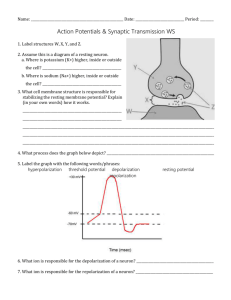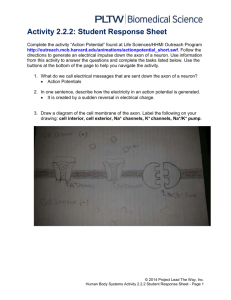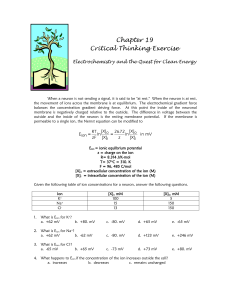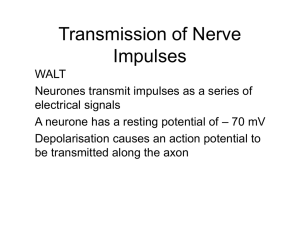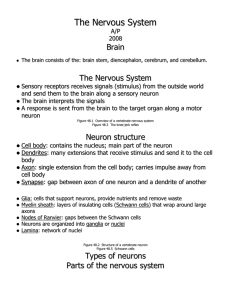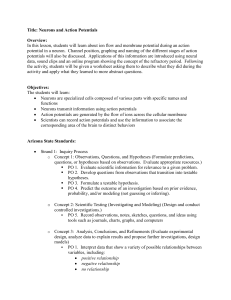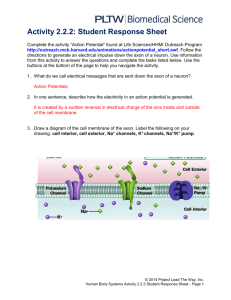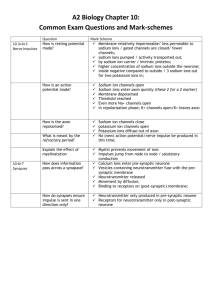Neuron Physiology and Synapses
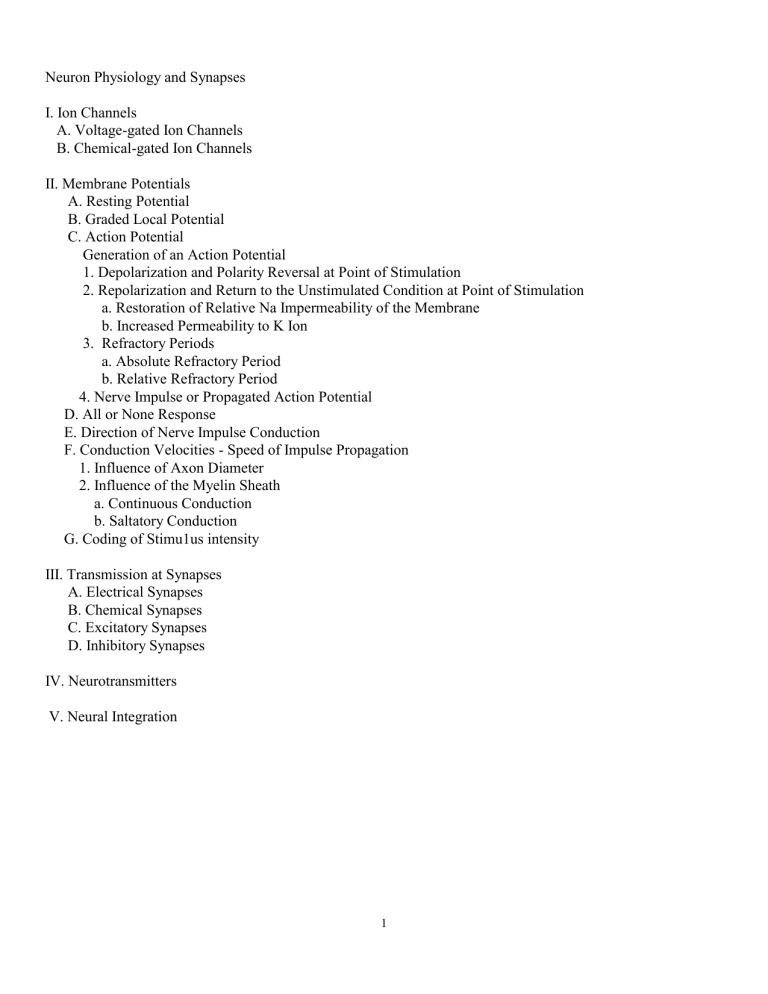
Neuron Physiology and Synapses
I. Ion Channels
A. Voltage-gated Ion Channels
B. Chemical-gated Ion Channels
II. Membrane Potentials
A. Resting Potential
B. Graded Local Potential
C. Action Potential
Generation of an Action Potential
1. Depolarization and Polarity Reversal at Point of Stimulation
2. Repolarization and Return to the Unstimulated Condition at Point of Stimulation
a. Restoration of Relative Na Impermeability of the Membrane
b. Increased Permeability to K Ion
3. Refractory Periods
a. Absolute Refractory Period
b. Relative Refractory Period
4. Nerve Impulse or Propagated Action Potential
D. All or None Response
E. Direction of Nerve Impulse Conduction
F. Conduction Velocities - Speed of Impulse Propagation
1. Influence of Axon Diameter
2. Influence of the Myelin Sheath
a. Continuous Conduction
b. Saltatory Conduction
G. Coding of Stimu1us intensity
III. Transmission at Synapses
A. Electrical Synapses
B. Chemical Synapses
C. Excitatory Synapses
D. Inhibitory Synapses
IV. Neurotransmitters
V. Neural Integration
1
Neuron Physiology and Synapses
How do neurons conduct information and communicate with each other and with the effectors (muscles and glands)?
Neural function involves the membrane resting potential and the conveying of the membrane potential as the action potential or nerve impulse along the neuron and then across the synapse to the effectors.
1. Ion Channels
A. Passive or Leak Channels
These channels are always open so Na, K ions leaks across the cell membrane due to the activity the Na-K
exchange pump to establish the normal resting potential.
B. Active or Gated Channels
These channels are opened or closed in response to stimuli.
1.
Voltage-gated Ion Channels - the voltage-gated ion channels are characteristic of an excitable
membrane. An excitable membrane is one capable of generating and conducting an action potential.
The action potential is a flow of electric charges or current caused in cells by movement of ions.
The voltage-gated ion channels are opened or closed in response to stimuli. Opening of the
voltage-gated Na channels establish the generation of the action potential. The Na channel has two
gates, an activation gate and an inactivation gate. These gates control Na ion entry and stopping Na ion
entry into the cell. There is also K ion voltage-gated channels. These allow for outflow of K ions.
2.
Chemically-gated Ion Channels - these channel gates open or close when they bind specifically to
chemicals. ACH is an example of such a chemical. The receptor proteins on the cell membrane attach
to neurotransmitter substances and cause the gates for Na ions and K ions to open or close.
At the resting membrane potential, the gated channels are closed. A specific stimulus, electrical, mechanical or chemical opens the gated channels to alter the rate ions move across the cell membrane to change the resting membrane potential to the action potential.
II. Membrane Potentials
Cells of the body are electrically polarized at the cell membrane with the inside of the cell relatively
negative compared to the outside. However, the bulk of the solutions inside and outside of the cell are
electrically neutral. The polarity is measured as a difference in electric charges on either side of the cell at
the cell membrane. The separation of opposite electric charges has potential energy and is measured as
voltage. The voltage measured at rest is the resting membrane potential. Change in membrane potential from
the resting condition is the action potential. In the neurons and muscle cells propagation of the nerve
impulses are based upon the action potential.
2
A. Resting Membrane Potential
The cell membrane of a neuron is polarized inside negative and outside positive. The resting membrane
potential of an unstimulated neuron is about -70mv, i.e., the inside is relatively negative compared to the
outside. The difference in Na ion and K ion concentrations of the intracellular and extracellular fluids
accounts for the resting membrane potential. The characteristics and functions of the neuron’s cell
membrane are due differences in these ion concentrations.
The ionic concentration of the intracellular fluid (cytoplasm): positive ions - high K ion, low Na ion;
negative ions - high anionic protein (A
-
).
The ionic concentration of the extracellular fluid: positive ions - high Na ion, low K ion; negative
ions-high C1 ion.
To maintain the ionic concentrations at rest intracellularly and extracellularly:
1.
The cell membrane contains an active transport mechanism to pump Na ions out and K ions in.
When compared to the extracellular fluid, the intracellular fluid of an unstimulated or resting neuron contains a higher concentration of K ions and a lower concentration of Na ions. The extracellular fluid contains just the opposite, more Na ions than K ions.
2.
The cell membrane is not equally permeable to all ions. The K ions are 75 times more permeable
compared to Na ions. Even though K ions are actively transported in, they easily diffuse out.
3. Impermeability of the cell membrane to large anionic proteins prevents the large negatively charged
protein ions to diffuse out, while membrane are freely permeable to Cl ions.
As a result of Na ions being pumped out and K ions diffusing out, the positive charged ions accumulate outside the membrane and since the large anionic or negative charged protein ions cannot diffuse out, negative charges accumulate on the inside of the membrane. This separation of the positive and negative charges across the membrane gives rise to the resting membrane potential.
What are the forces that influence movement of the Na ions and K ions across the cell membrane on stimulation?
B. Graded Local Potential
When the cell membrane of the neuron at a point is stimulated, it undergoes some degree of depolarization
i.e., the resting potential changes toward zero. The membrane in the area of stimulation demonstrates an
increased permeability to Na ions. This movement of Na ions across the cell membrane is from
extracellular to intracellular fluid. The Na ion movement into the cell is due to the concentration gradient
for the Na ions and electrical forces (positive outside, negative inside) that favors movement into the
cytoplasm of the cell. If the depolarization is slight, increase permeability to Na ions is slight, and the
inward movement of the Na ions is quickly balanced by the outward movement of the K ions, the
depolarization is decreased in the neuron at this point. A transient, local depolarization or local potential
occurred. The local potential in the area of stimulation of the neuron then returns to its unstimulated state.
The local potential is graded and it increases in magnitude with increase strength of the stimulus.
3
C. Action Potential
The generation and propagation of action potentials are the principle way neurons and muscle cells
communicate (receive, integrate and send information). Definition of the action potential: It is a brief large
depolarization or change in voltage of an amplitude of 100 mv (-70 to +30 mv). When a stimulus is applied
to the neuron, at the point of stimulation, the stimulus changes the membrane permeability to the ions. The
ions move across the membrane to change membrane potential. If the stimulus is of sufficient intensity to
reach a critical level or threshold, the stimulus causes the neuron to depolarize by 15-20 mv from resting,
about -70 to -55 mv. Then the depolarization continues without any further external stimulation. At the point
of stimulation, the membrane potential quickly decreases to zero and then reverses, so the inside of the
neuron at point of stimulation becomes relatively positive compared to the outside. The rapid depolarization
and polarity reversal leads to generation and propagation of the action potential. These two physiological
activities are unique to neurons and muscle cells.
There are two questions to answer.
How does the action potential develop and subside at the point of stimulation of the cell membrane?
How does the action potential travel or propagate along the cell membrane?
1. Depolarization and Polarity Reversal at the Point of Stimulation - Generation of the Action Potential.
Action potential generation is caused by three sequential overlapping changes in membrane permeability
caused by depolarization of the membrane at the point of stimulation.
As a local depolarization of a neuron approaches threshold, the cell membrane at the depolarized area has
a transient increased permeability to Na ions. The Na ions move rapidly into the neuron. This inward
movement of Na ions in turn further increases membrane permeability to Na ions and more Na ions move
into the neuron to further depolarize the neuron as the activation gates of the voltage ion channels open.
When a neuron is depolarized to threshold (-60 to -55 mv), the neuron no longer requires the stimulus to
cause the depolarization. The depolarization becomes self-generating. Just the inward movement of the
Na ions cause a depolarization, which further increases permeability of the membrane to Na ions. Thus
the action potential is an example of positive-feed back mechanism. As a result, the original polarity of
the neuron at the point of stimulation decreases to zero (depolarization) and then reverses so the inside of
the neuron becomes relatively positive compared to the outside.
2. Repolarization - Return to the Unstimulated Condition or Resting Membrane Potential at Point of
Stimulation
To restore relative impermeability of the membrane, increased permeability to Na ions at the point of
depolarization of the neuron’s membrane is short, about 1msec. and is self-limiting. As the membrane
potential becomes +30 mv inside the neuron, the positive charges resist further Na ions entry and the
membrane becomes increasingly impermeable to Na ions. Inactivation gates for Na ions close, Na ion
influx declines and stops. In addition, the voltage-gated K ion channels open.
4
3. Voltage-gated K ion Channels
As the membrane becomes impermeable to Na ions, an increased permeability to K ions immediately
follows. The increase permeability to K ions is longer than the increased permeability to Na ions. As a
result there is movement of K ions out of the neuron through the voltage-gated K ion channels. This causes
the inside of the neuron to become less positive and the outside of the neuron more positive. At the point of
stimulation, there is a rapid decreased in membrane permeability to Na ions and increased permeability to
K ions to repolarize the membrane and reestablishes the original or normal unstimulated polarity of the
neuron's membrane This reestablishes the resting electrical conditions (resting potential), but does not
restore the original ionic distribution (concentrations) of Na ions and K ions of the resting condition. The
Na-K ionic pump restores normal Na-K ion distribution. The pump moves the K ions back into the cell and
move the Na ions out of the cell.
2. Nerve Impulse or Propagated Action Potential
How is the action potential or nerve impulse propagated along the membrane of the neuron? If the action
potential is to serve for communication, it must be propagated along the length of the neuron.
Depolarization
At the point the action potential is initiated, the outside of the membrane becomes negatively charged
compared to the adjacent point. At the point of stimulation, the inside of the membrane becomes positively
charged compared to the adjacent point. This is polarity reversal. A local current flow is setup by polarity
reversal. The positive Na ions flow laterally inside the neuron from this positive area to the adjacent
negative area, as the positive charges are attracted to the negative charges of the adjacent area. This flow of
positive charges change the membrane's permeability of the adjacent area. Now at this point the Na ions
flow in across the membrane from the outside. Consequently, the immediate adjacent area is depolarized
by the local current flow. At this point on neuron’s membrane the action potential now occurs. Then the
next adjacent area of the membrane depolarizes and the action potential occurs here. Thus a
self-propagated nerve impulse continues along the length of the neuron's cell membrane. Since the
depolarization leads to negative charges on the outside, the action potential can be considered as a wave of
negativity that is self-propagating along the outside of the neuron’s membrane.
Repolarization
At the point of stimulation, the voltage-gated K ion channels open, K ions diffuse out. This restores the
negative charges on the inside and positive charges on the outside of the cell membrane. Then the Na-K
pump restores the resting ionic concentrations for Na ions and K ions.
D. Refractory Periods
1. Absolute Refractory Period
During the period of increased Na ion permeability if a second stimulus is applied to the initial
stimulated region of the membrane it does not evoke another action potential, no matter how strong the
stimulus might be. This period is the absolute refractory period. The length of time of the absolute
refractory period limits the number of action potentials that can pass down the neuron. The maximum
frequency is about 500 action potentials/sec.
5
2. Relative Refractory Period
At the point of initial stimulation due to increased K ion permeability a stronger than normal stimulus
can evoke a second action potential. This period is the relative refractory period.
E. All or None Response
Once a neuron is depolarized to threshold and an action potential is triggered, the action potential travels at a
rate and magnitude independent of the strength of the stimulus. The action potential has the same magnitude
whether triggered by a threshold stimulus or a stronger stimulus, thus an all or none response. The action
potential in a neuron and in the muscle cell and the muscle cell's contraction, once threshold is reached is
not graded.
F. Direction of Action Potential Conduction
In the body the action potential travels in one direction, starting at the dendrites traveling through the
perikaryon and ends at the axon terminals. At the synapse, the unidirectional travel of the action potential is
due to the organization of the neuron. The action potential can be conducted in both directions by any part of
the neuron.
G. Conduction Velocities - Speed of Action Potential Propagation
The axons have different thresholds and conduct action potentials at different velocities.
1. Influence of axon diameter - the larger the axon's diameter, the lower the threshold and greater the rate of
conduction velocity. The larger axon has, a greater cross sectional and membrane surface area, thus lower
resistance and a larger path for current to flow. This allows adjacent membrane areas to be depolarized
more quickly.
2. Influence of the Myelin Sheath - Continuous vs. Saltatory Conduction
Myelinated axons display action potential conduction called saltatory (jumping) conduction. Since myelin
is a good insulator, it has high resistance to current flow. Where the myelin is interrupted the local current
flow is from neurofibril node (node of Ranvier) to neurofibril node.
The action potential does not occur all along the length of the myelinated axon only at the neurofibril nodes
where there is only bare cell membrane of the axon between the intracellular and extracellular fluids. As a
result an action potential in a myelinated axon jumps along the axon from node to node. Thus the nerve
impulse travels faster in a myelinated axon than in an unmyelinated axon where there has to be
point-to-point depolarization.
6
H. Coding of Stimulus Intensity
How can you detect stimuli of differing intensities, if the action potentials are all the same size (all or
none)?
There are two factors that code for stimulus intensity:
1.
The main factor is frequency of action potentials, i.e., how many action potentials are generated/unit of
time. A light stimulus, for example light touch, generates a low frequency of action potentials. A heavy
stimulus, for example firm touch, generates a high frequency of action potentials passing down the
neuron.
2.
Number of neurons activated by the stimulus - light stimulus generate less action potentials than a
heavy stimulus.
III. Transmission at Synapses
Flow of information in the nervous system is transferred from one neuron to another at neuronal junctions,
the synapses. A neuron that transmits information toward a synapse is the presynaptic neuron. A neuron that
transmits information away from the synapse is the postsynaptic neuron.
Near the end of a neuron, the axon branches into axon terminals. Between the presynaptic neuron's axon
terminals and the postsynaptic neuron's dendrites and/or perikaryon are the synapses.
A. Electrical Synapse
In the human nervous system electrical synapses do not occur very often. These synapses are the gap
junctions found between the cardiac muscle cells.
B. Chemical Synapse
The synaptic cleft (a small space) prevents direct electrical transmission of the nerve impulse between
presynaptic and postsynaptic neurons. A neurotransmitter substance is released from the presynaptic
neuron, diffuse across the synaptic cleft and is received by the neurotransmitter receptors on the
postsynaptic neuron. On the postsynaptic neuron, the neurotransmitter substance changes the membrane
permeability and membrane potential. This establishes the action potential on the postsynaptic neuron.
1. Information Transfer across a Chemical Synapse - when the action potential arrives at the axon
terminal of the presynaptic neuron, it increases permeability of the axon terminal to Ca ions as
voltage-gated Ca ion channels open. The Ca ions move into the neuron from the extracellular fluid.
At the axon's terminal, increase in the intracellular Ca ions promote fusion of the synaptic vesicles,
containing the neurotransmitter substance, to the axon membrane. Then by exocytosis into the synaptic
cleft there is secretion of the neurotransmitter. To prevent continued neurotransmitter
secretion, the free Ca ions in the neuroplasm of the axon terminal is quickly removed. The
The neurotransmitter substance then transmits information by diffusing across synaptic cleft.
7
Then the neurotransmitter attaches to the receptors on the membrane of the postsynaptic neuron to
initiate a series of events. The membrane's permeability of the postsynaptic neuron is increased or
decreased by either opening or closing the chemically-gated ion channels. The result can be either
excitatory or inhibitory, it depends on the types of neurotransmitter substances released and the types
of postsynaptic neuron receptors.
2. Synaptic Delay - the action potential travels in a neuron very rapidly, but the speed of transmission at
the synapse is slower. This time delay is due to time required for release of the neurotransmitter from
the presynaptic neuron, diffusion across the synaptic cleft, attachment of the neurotransmitter to the
receptors on the gated channels in the postsynaptic neuron. The synaptic delay is about 3-5ms and thus
limits the rate of neural transmission.
C. Excitatory Synapse
At an excitatory synapse, the binding of the neurotransmitter substance to the receptors on the membrane of
the postsynaptic neuron increases the likelihood that this neuron will transmit a nerve impulse. The
neurotransmitter substance here causes opening of the chemically-gated Na and K ion channels.
Depolarization of the postsynaptic neuron’s cell membrane is caused by an excitatory postsynaptic potential
(EPSP). At the excitatory synapse, the neurotransmitter-receptor combination increases membrane
permeability to both Na ions and K ions. Since the diffusion gradient for Na ions is greater than for K ions,
the influx of the Na ions causes depolarization of the postsynaptic neuron. A nerve impulse will be triggered
in the postsynaptic neuron if the depolarization reaches threshold level. The EPSP is a graded potential. The
neurotransmitter substance causes the EPSP to vary in magnitude depending on its degree of stimulation of
the postsynaptic neuron. If the stimulation is sufficiently intense, the EPSP of the postsynaptic neuron
depolarizes to threshold and a nerve impulse is triggered.
D. Inhibitory Synapse
At an inhibitory synapse the binding of neurotransmitter substance to the receptors on the membrane of the
postsynaptic neuron closes the chemically-gated Na ion channels while opening the K and C1 ion-gated
channels. At the inhibitory synapse there is a decreased permeability to Na moving into the neuron. At the
same there is increased permeability to K ions moving out and C1 ions moving in. This causes an inhibitory
postsynaptic potential (IPSP) that hyperpolarize the membrane and increases the resting polarity of the
neuron. Under these conditions a stronger than normal excitatory stimulus is required to trigger a nerve
impulse in the postsynaptic neuron.
IV. Neurotransmitter Substances
Neurotransmitter substances are made by the neurons that secrete them. After their manufacture, the
neurotransmitter substance is stored in the synaptic vesicles. When a nerve impulse arrives at the axon
terminal, Ca ions diffuse into the axon terminal. Then the synaptic vesicles fuse with the membrane of the
axon terminal and the neurotransmitter substances are released into the synaptic cleft. Usually one type of
neurotransmitter substance is released from the axon terminals of a particular neuron.
When neurotransmitter substance combines with receptor sites on the dendrites and/or perikaryon of the
postsynaptic neuron there are permeability changes of the postsynaptic neuron's membrane as the
chemically-gated ion channels either open or close and postsynaptic potentials are generated.
8
The postsynaptic potential does not last very long. The neurotransmitter substance is removed from the area
of the receptors by enzymatic inactivation, diffusion of the neurotransmitter away from the region or
reabsorption back into the presynaptic neuron.
Examples of neurotransmitter substances.
Neurotransmitters that cause EPSP
Acetylcholine (ACH) released by neurons at the neuromuscular junction is excitatory but is inhibitory to
visceral effectors. Acetylcholine esterase (ACHE), an enzyme released from the postsynaptic neuron,
inactivates ACH.
In the brain there are neurotransmitter substances called biogenic amines or catecholamines. Norepinphrine
may be either excitatory or inhibitory depending on the condition.
Amino acids - glutamatic acid and aspartic acid produce EPSP.
Neurotransmitters that cause IPSP
The amino acid, gamma-aminobutyric acid (GABA) is an inhibitory neurotransmitter substance in the brain.
The amino acid, glycine has an inhibitory effect on the spinal cord. The biogenic amines, dopamine and
serotonin has an inhibitory effect.
The newest discovered neurotransmitter substances are nitric oxide (NO) and carbon monoxide (CO).
V. Neural Integration - Neuronal Circuits
The nervous system integrates information to produce coordinated responses to the stimulus. Integration
depends on divergence, convergence, summation, facilitation and modulation of the nerve impulse.
9
10
11
12
13
